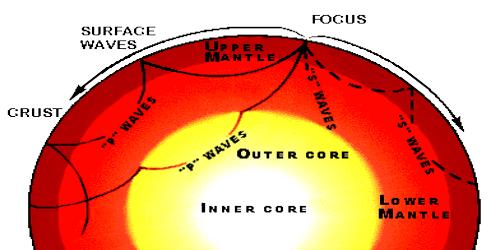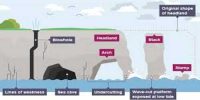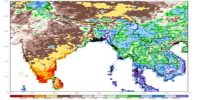The study of seismic waves provides a comprehensive representation of the layered interior. An earthquake in simple words is shaking of the earth. Earthquakes are usually caused when rock underground suddenly breaks along a fault. It is a natural incident. It is caused due to the discharge of energy, which generates waves that travel in all directions. This sudden release of energy causes the seismic waves that make the ground shake. The shaking is caused by movements in Earth’s outermost layer. Earthquakes are caused by the unexpected movement and fracturing of rock masses along preexisting faults.
A fault is a broken surface within the Earth’s crust. The point on the fault at which the displacement begins is called the “focus” of the earthquake. The discharge of energy occurs along a fault. A fault is a sharp fracture in the crustal rocks. They don’t just slide smoothly; the rocks catch on each other. Rocks along a fault are predisposed to move in opposite directions. The rocks are still pushing against each other, but not moving. As the overlying rock strata press them, the friction locks them together. After a while, the rocks break because of all the pressure that’s built up. However, their tendency to move apart at some point in time overcomes the friction. As a consequence, the blocks get collapsed and ultimately, they slide past one another unexpectedly. This causes a discharge of energy, and the energy waves travel in all directions. When the rocks break, the earthquake occurs. The point where the energy is released is called the focus of an earthquake, alternatively, it is called the hypocentre. The spot underground where the rock breaks are called the focus of the earthquake. The energy waves traveling in dissimilar directions reach the surface. The point on the surface, adjacent to the focus, is called the epicenter. It is the initial one to experience the waves. It is a point directly above the focus.
The seismic waves generated by an earthquake can be recorded and measured on a seismograph. The interpretation of the waves provides seismologists with a way of “seeing” into the inside of the Earth. The waves produced by earthquakes travel through the Earth and bounce off dissimilar features of the Earth’s interior. The patterns they form after bouncing off these features can be used to create images of the interior.
The main causes of earthquakes fall into five categories:
- Volcanic Eruptions
Such type of earthquakes occurs in areas, with frequent volcanic activities. Movement of lava beneath the surface of the earth can also cause certain disruptions. This sends shockwaves through the earth, causing damage. These earthquakes are mild. Their range is also limited.
- Tectonic Movements
The surface of the earth consists of some plates, comprising of the upper mantle. These plates are always moving, thus affecting the earth’s crust.
- Geological Faults
A geological fault is known as the displacement of plates of their original plane. These planes are not formed suddenly but slowly develop over a long period. The movement of rocks along these planes brings about tectonic earthquakes. These faults occur due to the impact of geological forces.
- Man-Made
Nuclear bombing can send specific types of shockwaves throughout the surface of the earth, which can disturb the natural alignment of tectonic plates. Mining can also cause disturbance due to the extensive removal of rocks from different areas.
- Minor Causes
Some minor causes such as landslides, avalanches, the collapse of heavy rocks, etc. can also cause minor shockwaves. The gases beneath the surface of earth contract and expand, giving rise to movements in plates beneath the crust.














